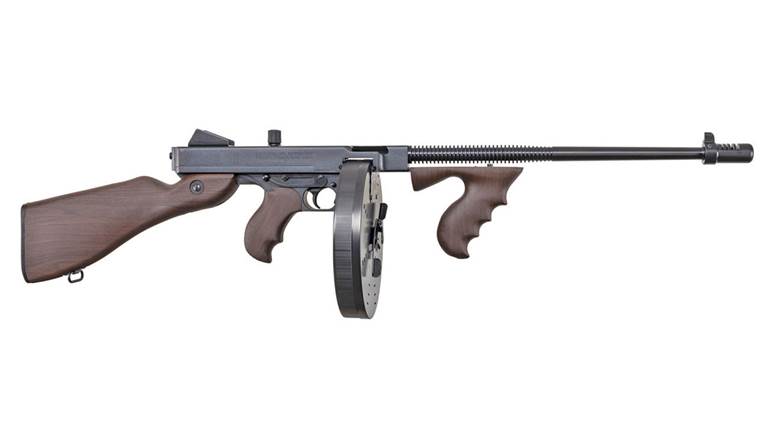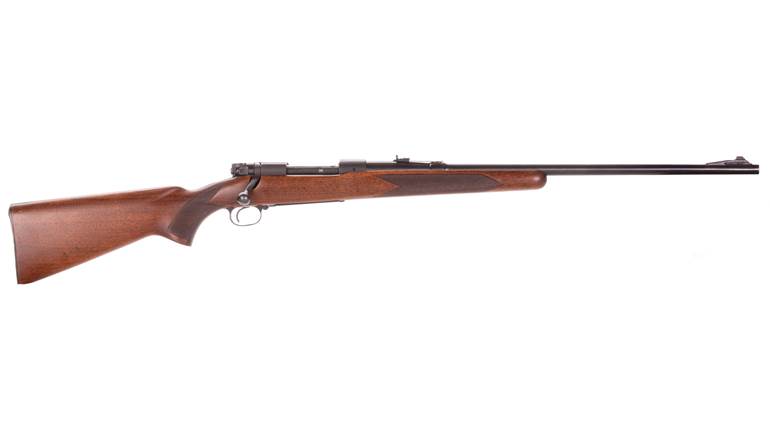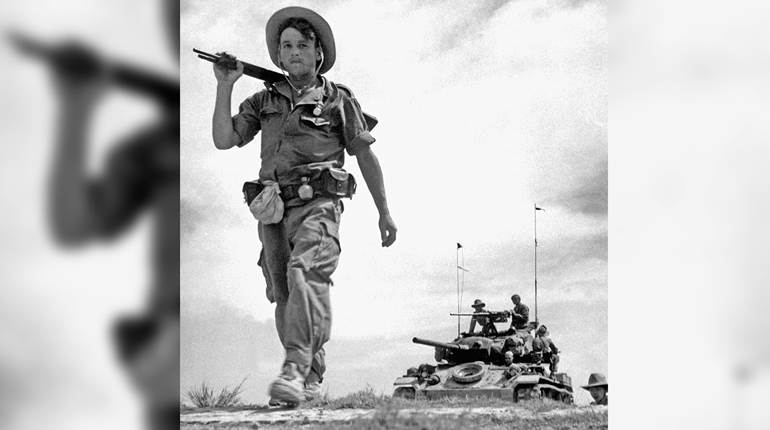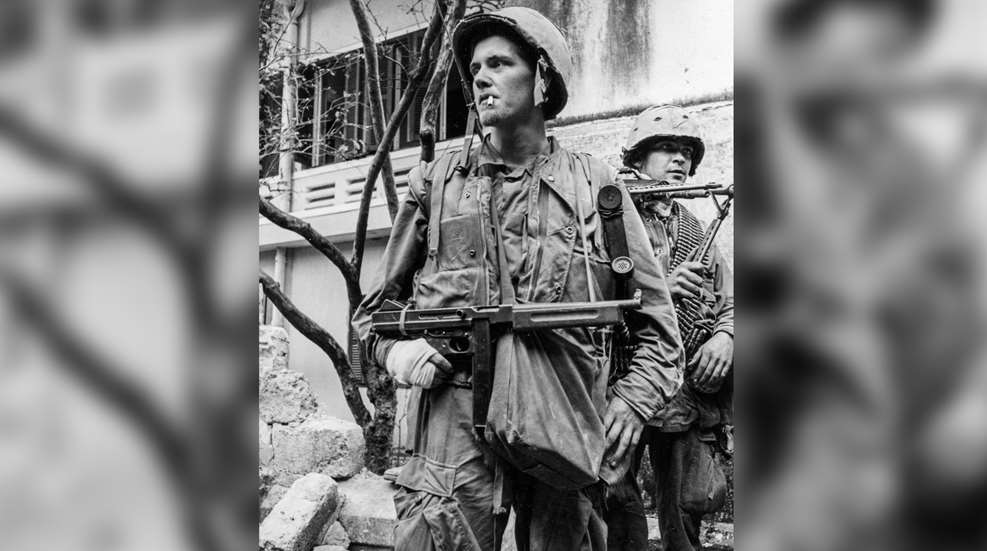
Lance Corporal C.D. Bradford, a radio operator in Company G, 2nd Battalion, 5th Marines is seen here on Feb. 5, 1968, during the building-to-building fight for the modern district of Huế south of the river. Note that Bradford is armed with an M1A1 Thompson submachine gun that has had its buttstock removed.
It was the first taste of city fighting for the Marines since Seoul, and it was a battle they were not trained to fight. They had, by early 1968, experienced everything that jungle warfare had to offer, but combat in an urban environment presented another matter entirely. Nevertheless, the fight that developed in the streets of Hue would give the Marine Corps one of its most memorable victories—a victory that marked the end of the Tết Offensive as well as a turning point in the war in Vietnam. It started during the pre-dawn darkness of Jan. 30, when the Tết Nguyên Đán lunar new year uprising struck hundreds of military installations, towns and provincial capitals across South Vietnam.
In Huế, two battalions of the 6th North Vietnamese Army (NVA) Regiment attacked the western wall of the city’s 19th-century Citadel just after 2:30 a.m. on Jan. 31 and proceeded to capture Tây Lộc Airfield and the grounds of the Imperial Palace. By 8 a.m., 60 percent of the citadel was in communist hands, and the Việt Cộng flag was flying over the ramparts of its south gate. In the modern sector of the city south of the Perfume River, the 4th NVA Regiment conducted a simultaneous attack that captured practically everything except the prison, a boat ramp and the compound of buildings being used as the local headquarters for the U.S. Military Assistance Command, Vietnam (MACV).
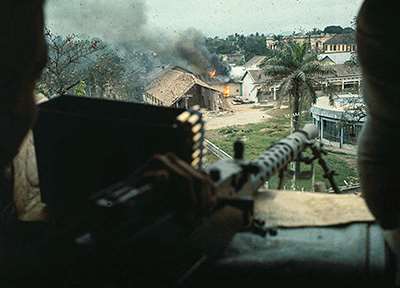
While outnumbered U.S. and South Vietnamese forces on both sides of the river managed to prevent the enemy from overrunning the entire city, the situation had nevertheless become critical—so much so that Gen. Ngô Quang Trưởng, commanding the 1st Division of the Army of the Republic of Vietnam (ARVN), called in reinforcements. With that, the stage was set for the battle that would rage across Huế for the next four weeks—a battle in which examples of old firepower fought alongside examples of new firepower in a clash of arms that, in the end, would reduce the city to ruin.
Before sunrise on Jan. 31, 1968, South Vietnamese airborne and armored cavalry units approached the city but found it impossible to break through to the fighting forces still holding ground there. Heavy fire from the Huế citadel drove back two battalions of the 3rd ARVN Regiment, and enemy counterattacks then surrounded its other two battalions, all of which were armed with the U.S. M1 rifle.
Although a more modern rifle was already being issued to units of the South Vietnamese army, in early 1968, most of the fighters were still armed with the Garand, which, by that time, had been in active service for three decades. Nevertheless, the M1 remained a reliable and powerful battle implement, albeit a bit of a throwback to the type of firepower that fought Germany, Japan and Italy a generation earlier. But the M1 rifle was not the only World War II firearm used in Huế during the battle, and the South Vietnamese were not alone in their use of guns from that conflict. At Phú Bài Combat Base just 10 miles to the south, a brigade-size component of the 1st Marine Division, code-named Task Force X-Ray, began moving toward Phú Bài Combat Base Huế just after 4 a.m. on Jan. 31. While the Marines brought examples of modern firepower with them, some of their small arms belonged to the bygone era of World War II.
During the first few days of the battle in Huế’s new city, the 2nd Battalion, 5th Marine Regiment (or “2/5”) pushed west from the MACV compound along the south bank of the Perfume River with the objective of clearing the grounds of the city’s university, the post office, the radio station, the soccer stadium and the provincial hospital. The Marines of Company G, 2/5 experienced the fighting one building at a time during this phase of the battle, so progress was slow and dangerous. During the afternoon of Feb. 5, 1968, a photographer snapped a memorable shot of a Company G radio operator identified as L/Cpl. C.D. Bradford. In the photo, Bradford is armed with an M1A1 Thompson submachine gun with the buttstock removed. In addition to that, he had fashioned a field-expedient patrol sling out of a section of paracord, with one end tied to the front sling swivel and the other end tied around the rear of the receiver.
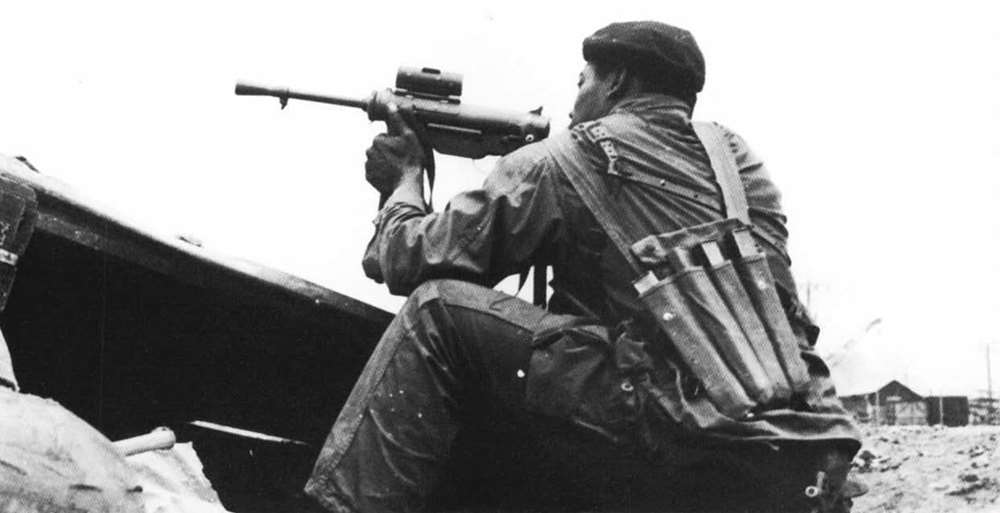
At about the same time, Sgt. Reginald Hicks of Company A, 1st Battalion, 1st Marine Regiment was photographed fighting with the M3A1 .45-cal. submachine gun in the area just to the southwest of the MACV compound. The “grease gun” shows up in several other photographs from the battle, proving that, while its use may not have been widespread, it was at least well-documented. Considering the close-quarters nature of the fighting in Hue, those old .45 ACP submachine guns were every bit as effective in 1968 as they had been in 1945.
When the 2/5 attacked the Thừa Thiên provincial headquarters on Feb. 6, 1968, it did so with tear gas and tank support, but the North Vietnamese soldiers defending the complex proved to be difficult to dislodge. Many of them were concealed in spider holes in the central courtyard, and Marines from Company H cleaned them out by overrunning the courtyard in one final push that was captured on film by a combat cameraman. In the motion-picture footage of this moment, Gy/Sgt. Frank A. Thomas, Jr. can be seen using another World War II firearm: the 12-ga. Winchester Model 12. Designed by Thomas Crossley Johnson, the shotgun served during World War I and then during World War II in its riot and trench configurations, and the riot version was still in use by the Fleet Marine Force in early 1968. But there were also John Browning-designed firearms being used in the streets of Huế during the battle.
Both ARVN and U.S. forces used his M1911A1 pistol, and his M1919A4 .30-cal. machine gun rolled into town on the M50A1 Ontos self-propelled anti-tank vehicles that provided critical fire support. An example of the A6 version of the M1919 even shows up in two famous photographs of a South Vietnamese light machine gun team’s fighting position on the second story of a building near Tây Lộc Airfield. Finally, the Browning-designed M2HB .50-cal. heavy machine gun armed ARVN and USMC tanks involved in combat in the city; so, John Browning’s engineering legacy played a meaningful part in the Battle of Huế.
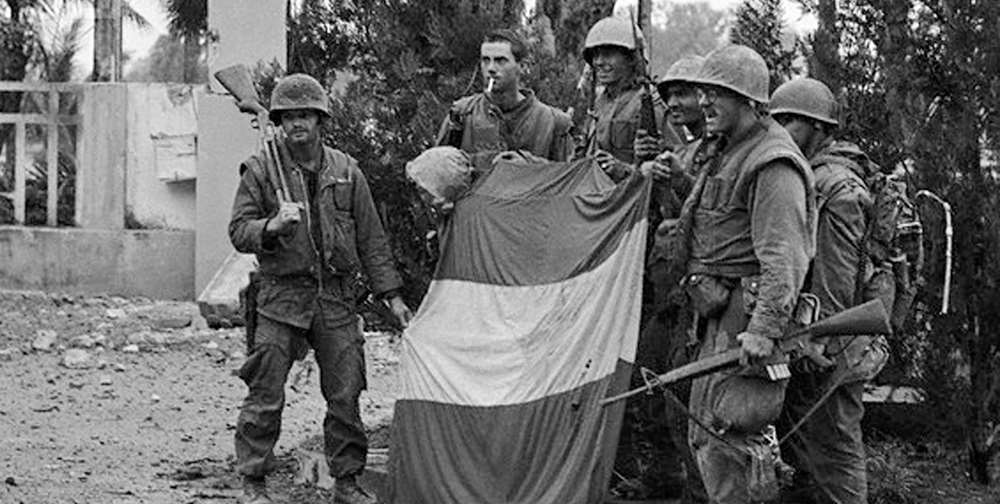
After clearing the south side of the river during the beginning of February, Task Force X-Ray then joined the fight against the areas of the citadel still occupied by the enemy in strength. Up till then, only the 1st ARVN Division had been waging battle against the main pocket of Việt Cộng/NVA resistance centered on the Imperial Palace. Beginning on Feb. 12, though, Marines of the 1/5 were also a part of the fight there. They crossed the river in landing craft and then began an attack from the east that ultimately descended on the Đông Ba Tower—an especially well-defended part of the eastern outer walls surrounding the citadel. On Feb. 15, 1968, Company D (1/5) led an attack on the tower that ultimately produced some of the most intense combat of the entire campaign.
Captain Myron Harrington, commanding Company D, 1/5, described what he saw there as “utter devastation,” and he described the noise of battle as being “almost unbearable.” In addition to small-arms fire, the sound of artillery characterized this phase of the fight as well. From the outset, ARVN Gen. Trưởng banned the use of artillery support in what turned out to be a fruitless attempt to spare the city from devastation, but, by mid-February, it had become clear that the stakes were simply too high, so he lifted the ban. With that, field artillery from Phú Bài and even naval gunfire from offshore rained down on the area around the Đông Ba Tower. Despite that, though, Việt Cộng and NVA small-arms fire endlessly swept the Marine positions. Captain Harrington remembered it like this, “There were a thousand places that a rifle or a machine gun could be placed to fire at you that you just really had no awareness of until they started firing.”
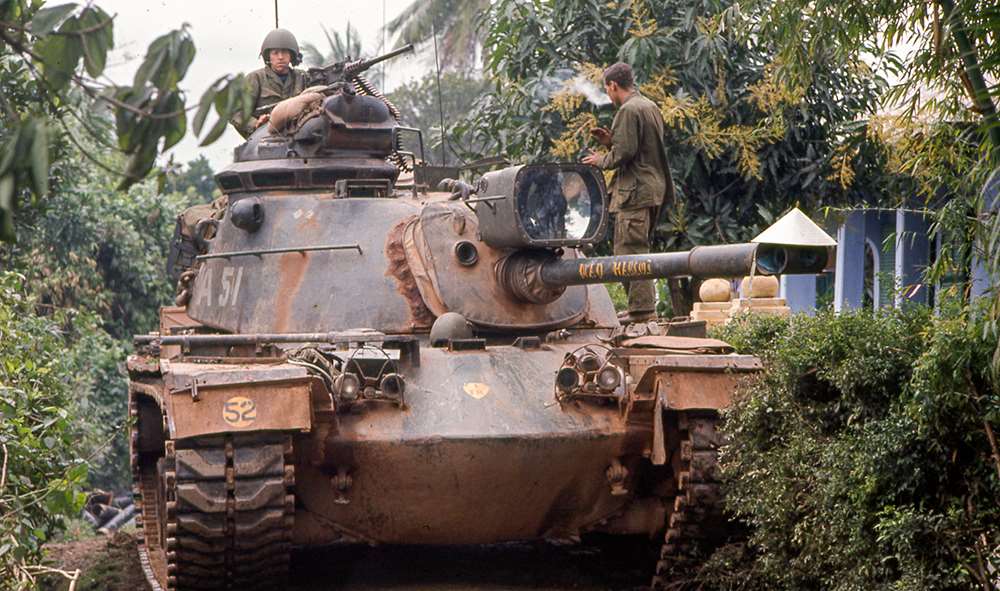
The three main infantry rifles being used by NVA maneuver battalions in 1968 were of Russian origin: the Type 53 bolt-action carbine (a Chinese-produced version of the M44 Mosin-Nagant carbine), the Type 56 semi-automatic rifle (a Chinese-produced version of the SKS) and the gun that was doing most of the fighting for the North Vietnamese by 1968—another Type 56, this one a Chinese version of the Type 3 AK-47. Việt Cộng and NVA units also made effective use of the Type 56 light machine gun, a Chinese version of the Russian RPD. In addition to B-40 rockets from the RPG-2, recoilless rifles and mortars, these guns provided the firepower that the communists used to oppose Company D, 1/5 at the Đông Ba Tower on Feb. 15.
The fact that the enemy was concealed in fighting positions inside the tower made matters all the more difficult, and there was really only one solution to the problem: Capt. Harrington ordered one of his rifle squads to charge it. That squad was led by Cpl. Maurice P. Whitmer, and it immediately came under a heavy volume of small-arms fire that temporarily halted progress. Corporal Whitmer later described what happened next: “Everybody’s diving for cover—we’re throwing grenades back and forth, and we got to about halfway through the tower and we’re running out of grenades and ammunition, and then we just started throwing bricks or anything else to make the enemy run.” With bullets “clicking” all around him and “whining” overhead, the 20-year-old squad leader “boldly moved forward through the intense fire, leading an assault against the hostile force that overran the enemy positions and enabled his company to seize its objective.” For that, Whitmer was ultimately awarded the Silver Star.
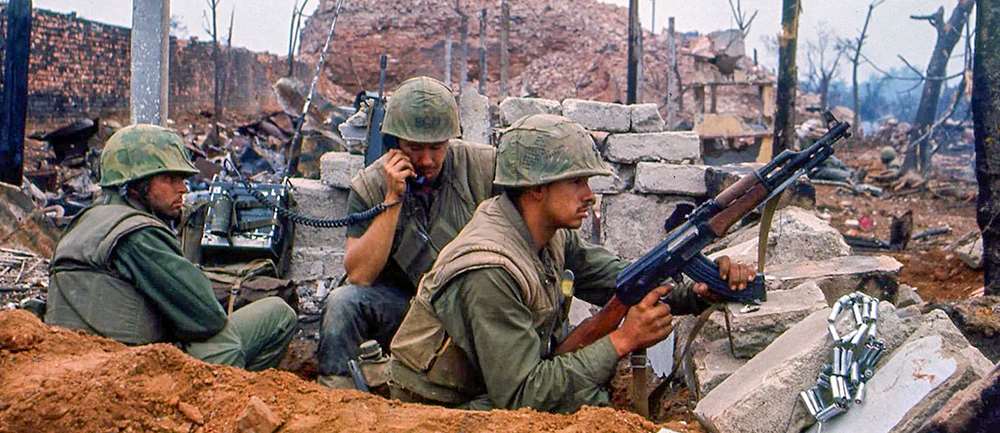
While Việt Cộng and NVA snipers inside the citadel could harass their opposition with effective rifle fire, the Marines did the same in return using an entirely new platform. In 1965, Remington Arms indicated a willingness to work with the USMC toward the creation of a customized sniper rifle. What the company ultimately submitted for evaluation was a modified version of its Model 700/40X target rifle that was chambered for the 7.62 NATO cartridge. The gun featured a free-floating, 24", medium-weight barrel with a 1:10" rifling twist, a one-piece wood stock with no checkering and two fixed sling swivels. It was built on the short-action Model 700 using a cock-on-open bolt and an internal box magazine with a five-round capacity. Remington delivered the rifles with a matte-Parkerized finish and a commercial Redfield 3–9X Accu-Range variable scope. The Marine Corps officially adopted the rifle on April 7, 1966, as the M40 and promptly ordered 700 units, several examples of which fought in the streets of Huế two years later.
But a modern sniper rifle was only a small part of the firepower organic to the three Marine battalions that fought the battle of Huế. Support weapons also armed each battalion; principal among them was one of the most successful machine-gun designs of the 20th century. In the aftermath of World War II, the U.S. government began to look for a single machine gun that could either advance with an attacking echelon or be used in fixed defensive positions with a tripod. In other words, a general-purpose machine gun (GPMG). After five years of development, in February 1957, the U.S. military adopted a belt-fed, gas-operated GPMG designed by the Inland Division of General Motors under the designation T161E—but it entered service under the military designation M60.
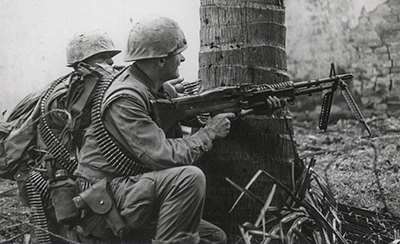
Firing from the open bolt and feeding the 7.62 NATO M80 cartridge using M13 metallic disintegrating links, this machine-gun design provided the U.S. military precisely the kind of multi-role flexibility it needed. For ground applications, it could be fired from its built-in bipod or mounted on the M122 tripod, and its 22" barrel could be changed easily and quickly by an assistant gunner. An air-cooled machine gun, the M60 delivered fire at a cyclic rate of between 500 and 650 rounds per minute. The troops referred to it as “the Pig” in recognition for its robust 23-lb. mass, and the firepower that it was capable of producing made it the most effective machine gun fighting the Battle of Hue.
As the Marines of Task Force X-Ray pushed beyond the Đông Ba Tower, the battle moved into its final phase. With ARVN battalions and South Vietnamese Marines to their right, the Americans struggled from block to block through the streets of the citadel’s southeast sector against heavy enemy resistance. During the week that followed, the Marine Corps’ new rifle—the Colt M16A1—was put to much strenuous use. Four years earlier, ARVN units and U.S. advisors had evaluated the rifle and left “extremely favorable” comments about its performance. Soon thereafter, the U.S. Air Force officially adopted it, followed by the U.S. Navy, which ordered a small number to arm its SEAL teams. After a few engineering changes, not the least of which affected the twist rate of the rifling, the U.S. Army and the Marine Corps began using the rifle under the designation XM16E1. Despite being described as “the best individual infantry weapon ever made” in 1965, the XM16E1 began to exhibit catastrophic problems in 1966. Reports from the field indicated that U.S. troops in Vietnam were experiencing chronic failures to extract, wherein the cartridge’s brass case would seize in the chamber and the extractor would tear through the rim. Such a stoppage could only be cleared by pounding the case out of the chamber from the muzzle end using a cleaning rod. Through the end of 1966 and into 1967, these malfunctions reached chronic levels and resulted in lives lost on the battlefield.
Nevertheless, on Feb. 28, 1967, the XM16E1 was standardized as the M16A1 at the height of the jamming epidemic, when troop confidence in the rifle was at an all-time low. Word of the problems endemic to the M16A1 soon reached U.S. Congressional leaders, and in May 1967, the House Armed Services Committee of the 90th Congress established the Special Subcommittee on the M16 Rifle with Representative Richard Ichord (D-Mo.) as chairman. The three-member “Ichord Committee” immediately went to work during the summer of 1967 investigating the matter and quickly determined that the root cause was ammunition, specifically gunpowder. When the 5.56 NATO M193 cartridge was first adopted by the military in September 1963, only DuPont’s IMR 4475 nitrocellulose powder was approved for loading it. Then, on April 28, 1964, a fateful decision was made to allow M193 ammunition to be loaded with Olin Mathieson’s WC 846 ball powder. A double-base nitrocellulose/nitroglycerine propellant, WC 846 exerted higher chamber and gas-port pressures and also left behind increased carbon fouling. These factors were ultimately to blame for the outbreak of XM16E1/M16A1 extraction failures in Vietnam. When the Ichord Committee submitted its 51-page final report in October 1967, it recommended the withdrawal of Olin Mathieson’s WC 846 ball powder and the immediate introduction of chrome chambers and bores on all production rifles. These changes eliminated the reliability problems that had plagued the M16 for more than a year.

So, just as the Tết lunar new year approached during the opening weeks of 1968, the often-tragic stoppages experienced with the XM16E1 and the M16A1 were fading quickly. The photographic record of the Battle of Huế shows examples of both the E1 and the A1 in use by the Marine Corps, and no other firearm can be observed in the city in comparable numbers. In fact, the M16 dominates the still photographs and motion-picture footage of the battle to such an extent that it is challenging to find imagery that does not include one. While the M14 is almost completely absent from the photographic record, what is revealed instead are endless shots of Marines fighting their way through the city with E1s and A1s equipped with 20-round magazines and frequently the M3 bipod or the M7 bayonet. Something else notably absent from written accounts of the battle are reports of malfunctioning rifles, so it would seem that the M16 was born again in the streets of Huế. Gone was the old and unreliable version of the rifle—here to stay was a new M16 that would ultimately be recognized as one of the most successful military rifles ever designed.
But the USMC was not alone in its use of the M16 during the fighting in and around . Many South Vietnamese units fought with it, as did the U.S. Army. Although the battle is best known for the Marine Corps, it is important to remember that the U.S. Army also fought to recapture Huế. Elements of the 101st Airborne Division and the 1st Cavalry Division (Airmobile) were involved in the battle, albeit not in the streets of the city itself. Nevertheless, U.S. Army soldiers used the same guns as their Marine Corps brothers, which is why there are photographs (for example) showing men of the 7th Cavalry Regiment armed with the XM16E1 engaged in a firefight on Feb. 21, 1968, at Thôn La Chữ just three miles northwest of the Imperial Palace.
Elements of the 1st Cavalry broke through to the southwest wall of the citadel on Feb. 24 just hours after South Vietnamese troops raised the flag of the Republic of Vietnam over the Kỳ Đài bastion along the river. By noon, the final pocket of NVA/Việt Cộng resistance on the southern wall of the citadel had been defeated. Mopping-up operations went on for another week and then, on March 2, the Marine Corps concluded Operation Huế City—the battle that it was not trained for but that it won, nevertheless.












